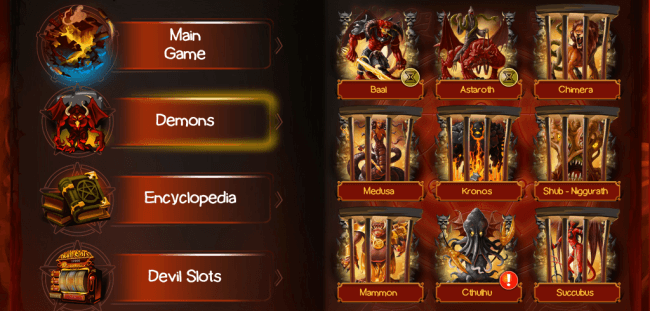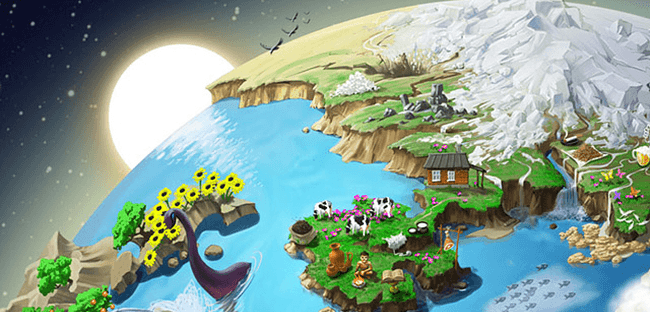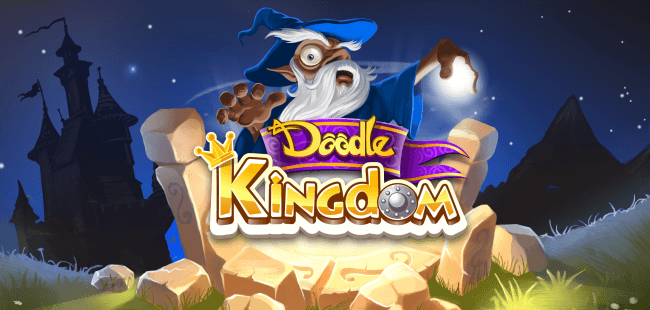- Wondering how to get Monopoly GO! free rolls? Well, you’ve come to the right place. In this guide, we provide you with a bunch of tips and tricks to get some free rolls for the hit new mobile game. We’ll …
Best Roblox Horror Games to Play Right Now – Updated Weekly
By Adele Wilson
Our Best Roblox Horror Games guide features the scariest and most creative experiences to play right now on the platform!The BEST Roblox Games of The Week – Games You Need To Play!
By Sho Roberts
Our feature shares our pick for the Best Roblox Games of the week! With our feature, we guarantee you'll find something new to play!Type Soul Clan Rarity Guide – All Legendary And Common Clans Listed!
By Nathan Ball
Wondering what your odds of rolling a particular Clan are? Wonder no more, with my handy Type Soul Clan Rarity guide.
JoyBits talks the evolution of Doodle God and the road to Doodle God 2
What once started out as a simple idea for a text-based web game about combining elements to make new ones has since spawned a handful of sequels on dozens of platforms, and is currently reaping the accolades of having over 100,000,000 user-downloads across all titles combined. That’s right: I’m talking about JoyBits’ simple and addictive Doodle God elemental crafting franchise. From its old text-based days, to finding new life on the iPhone in 2010, and gaining colorful graphics, unique and stylized humor, and so much more along the way, the Doodle God series is one of the most played, and most recognizable names in casual gaming today.
I recently had a chance to learn more about the evolution of Doodle God from JoyBits co-founders Anton Rybakov and Nick Kotlyarov, and to ask them a few questions about how their life lessons in mobile game development to date have since gone on to influence and shape the upcoming release of the highly anticipated Doodle God 2. Through emailing with Kotlyarov, I learned that the basic Doodle God formula was first expanded in two key areas: by creating thematic episodes such as Technology and Modern World, and populating each one with a series of thematic quests, like “Save the Princess from the Dragon.”
With this new content to the original Doodle God now in tow, JoyBits next set their sights on expanding the universe even further with spin-off games like Doodle Farm and Doodle Devil. Once those follow-up games got some good traction with players in the months after, it was time to revisit some of the now-classic Doodle God titles and reignite them with massive title updates. In particular, JoyBits is currently celebrating the launch of both “Doodle God 2.0” and “Doodle Devil 2.0,” each of which contains an awesome amount of new content and features.

What once started out as a simple idea for a text-based web game about combining elements to make new ones has since spawned a handful of sequels on dozens of platforms, and is currently reaping the accolades of having over 100,000,000 user-downloads across all titles combined. That’s right: I’m talking about JoyBits’ simple and addictive Doodle God elemental crafting franchise. From its old text-based days, to finding new life on the iPhone in 2010, and gaining colorful graphics, unique and stylized humor, and so much more along the way, the Doodle God series is one of the most played, and most recognizable names in casual gaming today.
I recently had a chance to learn more about the evolution of Doodle God from JoyBits co-founders Anton Rybakov and Nick Kotlyarov, and to ask them a few questions about how their life lessons in mobile game development to date have since gone on to influence and shape the upcoming release of the highly anticipated Doodle God 2. Through emailing with Kotlyarov, I learned that the basic Doodle God formula was first expanded in two key areas: by creating thematic episodes such as Technology and Modern World, and populating each one with a series of thematic quests, like “Save the Princess from the Dragon.”
With this new content to the original Doodle God now in tow, JoyBits next set their sights on expanding the universe even further with spin-off games like Doodle Farm and Doodle Devil. Once those follow-up games got some good traction with players in the months after, it was time to revisit some of the now-classic Doodle God titles and reignite them with massive title updates. In particular, JoyBits is currently celebrating the launch of both “Doodle God 2.0” and “Doodle Devil 2.0,” each of which contains an awesome amount of new content and features.
The set of 2.0 updates were so in-depth in both their execution and scope, that Kotlyarov tells me they might as well have been entirely new games in their own right. In addition to a slew of technical fixes, 13 new languages, and interface design tweaks, both game updates include everything from new puzzles and quests, to special artifact collectables for players to earn, and even a captivating new game mode called “Demon mode” released exclusively in the 2.0 update for Doodle Devil. And of course, everything that JoyBits has learned throughout the years of building and perfecting their growing Doodle empire, from the very first Doodle God game to the recent 2.0 title updates (all of which the team is now grouping together under the heading of “the first generation of Doodle games), has all been leading up to influence what is certainly going to be their crowning achievement to date: the upcoming, full-fledged Doodle God 2!

A look at the new “Demon mode” in Doodle Devil 2.0.
The pair of Rybakov and Kotlyarov tell me a little bit about what gamers can expect from the exciting new sequel, and how exactly the game will differ from Doodle God games of old. For one thing, Doodle God 2 is going to be much less abstract than previous installments in the series, as the developers plan to move from using simple base icons to represent each element, to including them in a rich and living world where players can touch their new physical creations as they coexist with one another. What’s more, each combination of elements in the game will now have a visual representation on the screen as different compounds fuse together to form new kinds of life: “if you mix and match a mountain and lava, players will immediately see a cool volcano appear!” Much like the first game, players will begin Doodle God 2 with the same four basic elements: although where they go from there, and what kinds of environmental reactions they cause in the constructing of their world could be anyone’s guess. All that’s for certain is that we can’t wait to play it.
In fact, to say that Doodle God 2 has been a long time coming would almost be an understatement, as the folks at JoyBits have actually been brainstorming ideas for the eventual sequel ever since they were in the middle of developing 2010’s original Doodle God game! Rybakov outlines for me just exactly how these once-simple ideas began to build and expand over time, and finally reach fruition after several Doodle games had seen their public release. Take the concept of allowing players to visualize the different elements and worlds they were creating, for starters. JoyBits first “started to experiment with these ideas on the original Doodle God and Devil games and started to gain confidence that we could pull it off in Doodle God 2.” In another prime example, Rybakov says “we also realized that the current gameplay in Doodle God is really targeting ‘Explorers,” but we wanted the sequel to target all types of players including ‘Achievers,’ ‘Socializers,’ and ‘Killers.’ In order to develop this type of game it requires us to create an entirely new game.”
 “The lively new world of Doodle God 2.
“The lively new world of Doodle God 2.
But with the changing of designs from game to game, JoyBits also had to start thinking about the changing of the times in the overarching game industry as well, as the free-to-play model quickly began overtaking the more traditional business plans of premium games. And while there’s no concrete details to give with regards to Doodle God 2 in this area just yet, JoyBits have in fact been looking into some options to make the upcoming sequel a free-to-play game, which they feel would in turn help boost the customizable nature of the actual game. However, for those of you who are still fighting tooth and nail to keep away from the industry trend of free-to-play games, JoyBits informs me that Doodle God 2 will also see an additional, more traditional premium release to please fans on that side of the fence as well.
You would almost think that for a game series like Doodle God that’s consistently pulling in such impressive numbers (currently over 100,000,000 downloads across 50 different countries!), a lot of the hard work would be coming easy by now. But Rybakov assures me that his team faced plenty of challenges along the way, especially in the last 18 or so months of development duties. For one thing, bringing the Doodle God series to over 20 different game platforms since 2010 was certainly no easy feat in of itself, as Rybakov tells me that doing so required upwards of 300 different game builds! This was certainly a staggering task for the tiny 25-person team at JoyBits, but the studio ultimately realized that the key to achieving this game platform perfecta was in creating their very own game engine, which they spent the better part of a year working on. According to Rybakov, “without our new engine, there is no way we could support all of the great platforms out there in addition to iOS and Android, like Amazon Appstore, Windows Phone, Windows 8, BB10, Nook, etc.” For the JoyBits team, creating their own engine was “the only way to support the range of monetization SDKs on modern platforms, which is vital to success.”

What new fun will be found in games like Doodle Kingdom?
And JoyBits is certainly no strangers to success lately, as if I need to throw around that 100,000,000 milestone one more time in this article. Taking every one of these challenges head on, JoyBits is showing no signs of slowing down any time soon, with tons of new Doodle game goodness in store for the remainder of 2013 and beyond. And if you thought the upcoming Doodle God 2 would be the tip of that iceberg for JoyBits, then you’d better check yourself quite promptly and think again, because the Doodle folks already have two additional themed games currently in the works, which are set to take that same tried and true gameplay formula and add some even further twists. While I can’t go into too much detail about what each one will ultimately entail, I can tell you to keep an eye out for both Doodle Kingdom and Doodle Creatures in the near future, in addition to the second generation of Doodle games that is set to begin with the advent of Doodle God 2.
More articles...
Monopoly GO! Free Rolls – Links For Free Dice
By Glen Fox
Wondering how to get Monopoly GO! free rolls? Well, you’ve come to the right place. In this guide, we provide you with a bunch of tips and tricks to get some free rolls for the hit new mobile game. We’ll …Best Roblox Horror Games to Play Right Now – Updated Weekly
By Adele Wilson
Our Best Roblox Horror Games guide features the scariest and most creative experiences to play right now on the platform!The BEST Roblox Games of The Week – Games You Need To Play!
By Sho Roberts
Our feature shares our pick for the Best Roblox Games of the week! With our feature, we guarantee you'll find something new to play!Type Soul Clan Rarity Guide – All Legendary And Common Clans Listed!
By Nathan Ball
Wondering what your odds of rolling a particular Clan are? Wonder no more, with my handy Type Soul Clan Rarity guide.







